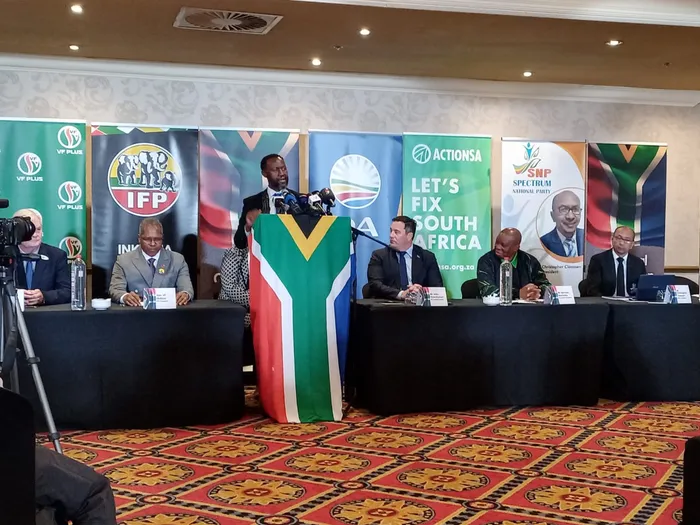Numbers don’t stack up in DA’s bid to seize power in South Africa

Picture: Kailene Pillay/IOL - What is likely to happen is that the ANC’s support will continue to decline as it has happened in the past elections but still retain power. In that case the Multi-Party Charter would have won the battle of weakening the ANC but still lose the war of totally removing the ANC from power, writes Prof. Bheki Mngomezulu.
By Professor Bheki Mngomezulu
History has a way of repeating itself. Those who care to value history draw lessons from it and plan their future from a confident position and avoid repeating the same mistakes.
Conversely, those who do not attach value to history despise it to their own detriment. If coalition governments have failed in various municipalities across South Africa, what makes the DA and its “like-minded” political parties believe that the Moonshot Pact, now called the “Multi-Party Charter for South Africa”, will survive? Has the DA corrected its previous mistakes in the Nelson Mandela Bay Metro and other metros in Gauteng? If not, this collective might be a stillborn child.
On October 25, 1991, Nelson Mandela, Chris Hani and other liberation fighters met at the World Trade Centre, now called Emperors Palace, in Kempton Park. It was here where the Convention for a Democratic South Africa (Codesa) talks began to map the future of this country.
To boost his confidence and those around him, DA leader John Steenhuisen convened his consultative meeting at the same venue. Mandela and his team succeeded in removing the National Party from power. Steenhuisen believes that if his efforts succeed to remove the ANC from power, he will have made history.
The main question becomes: Will this strategy succeed to remove the ANC from power? A secondary question would be: Will the collaboration be sustainable after making the ANC dispensable or will squabbles within the coalition destroy it?
To answer the first question, the group of seven political parties might succeed in reducing the ANC’s support but the ANC would still have higher numbers compared to the parties’ collective as was the case in the 2021 local government election. The Multi-Party Charter says that it needs 27 million votes to remove the ANC. Chances of obtaining this figure are very slim.
What is likely to happen is that the ANC’s support might continue to decline as has been the case in previous elections but it would still retain power. If that happens, the Multi-Party Charter would have won the battle of weakening the ANC but still lose the war of totally removing the ANC from power.
To answer the second question, the prospects of sustaining the coalition after weakening the ANC are almost non-existent. The glue that binds the parties together is the common enemy – the ANC. Another rallying point is the resolve to scuttle the EFF’s effort to grow. After the 2024 general election, the coalition will disintegrate because it is built on a shaky foundation.
Signs of weakness in the coalition were already visible on day one of the discussions on August 16. Firstly, of the 14 political parties that are represented in the National Assembly, only three joined the coalition talks. These were the DA, the Freedom Front Plus (FF+) and the IFP. The other four parties, which are not represented in Parliament, were ActionSA, the Independent SA National Civic Organisation (ISANCO), the United Independent Movement (UIM) and the Spectrum Party (SP).
Another blunder is to announce that the Multi-Party Charter does not want to work with either the ANC or the EFF. With both parties not being part of this coalition, the numbers will not add up. The three additional formations do not bring large numbers with them. Secondly, the combined figure of the remaining nine political parties currently represented in the National Assembly (excluding the ANC) would be higher compared to the four parties working together with three others that have no seat in the National Assembly currently.
The possibility of the DA’s double-standard of negotiating with the ANC secretly might ruin this multi-party collaboration at its infancy through trust deficit.
Moreover, deciding on who will lead the coalition cannot be an easy decision. Part of the reason is that the DA was the convenor of the convention. Therefore, the expectation was that the DA under Steenhuisen would automatically take the leadership position as has been the case in local municipalities.
As reality would dictate, not everyone shared this view. For example, the FF+ did not hide its feelings of wanting IFP leader Velenkosini Hlabisa to lead the coalition. Interestingly, Steenhuisen was prepared to be the deputy. Was the constituency consulted in this regard?
ActionSA national chair Michael Beaumont argued that the issue of who would lead the coalition would be discussed at a later stage once they had measured the popularity of each proposed leader.
Corroborating this view, UIM leader Neil de Beer argued that it was not a given that Steenhuisen would be the leader of the coalition just because he was the convenor. He added: “All this talk about John and the DA being big brother is utter rubbish. I will not allow that.”
The final agreement is that the party with more votes will lead. Whether this will be adhered to remains to be seen. Talk that other parties will be invited to join complicates the situation.
*Professor Bheki Mngomezulu is director of the Centre for the Advancement of Non-Racialism and Democracy at the Nelson Mandela University.